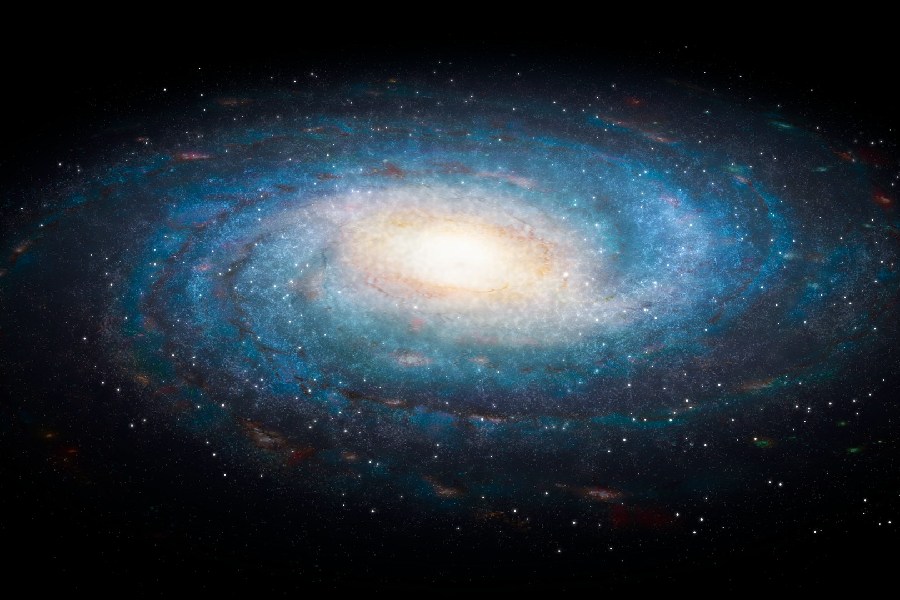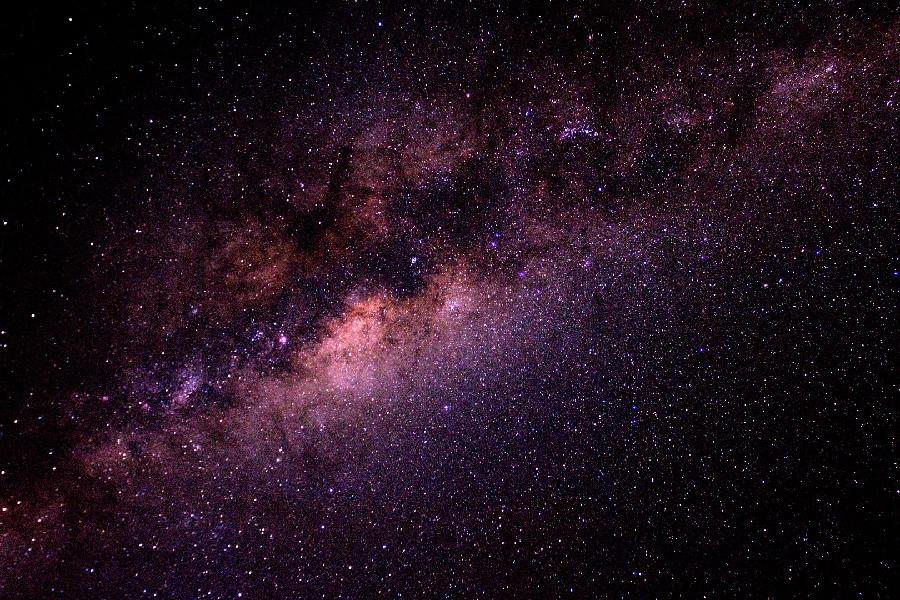We see a fraction of our home galaxy’s starry residents when we gaze at the breathtaking band of light that spans the night sky. The Milky Way galaxy houses an astonishing array of stars – from scorching blue giants to dim red dwarfs barely glowing across lightyears. But how many stars are in the Milky Way?
In this article, we will explore the techniques and observations used by astrophysicists. They employ these methods to estimate the number of glittering suns within the Milky Way’s sprawling borders.
As we explore the current state of knowledge regarding the Milky Way’s stellar population, we’ll look at our home galaxy as a magnificently ornate island universe and evolving. So, let’s get started and discover the number of stars in the Milky Way!

How Many Stars Are in the Milky Way?
Our expansive galaxy, the Milky Way, is home to approximately 100 to 400 billion stars. Though the exact count remains challenging due to its immense scale, scientists estimate this broad range, emphasizing the difficulty in pinpointing an exact number.
Simply put, our galaxy is teeming with many stars. This contributes to the breathtaking sea of suns filling the night sky.
Historical Perspective
Early attempts to estimate star counts
In the 1920s, astronomers used star counts in small sky areas. They scaled estimates up based on the Milky Way’s assumed dimensions. Harlow Shapley totaled up cataloged stars in all directions. He suggested 300 billion stars for the Milky Way’s combined disk and halo.
Advancements in observational technology and techniques
Initially, mass estimates relied on the galaxy’s combined luminosity in various wavelengths, like infrared and radio. This approach also involved measuring specific stellar populations to narrow the total mass.
Later on, surveys employing Charged Coupled Device (CCD) detectors significantly increased the number of cataloged stars. CCDs in digital cameras and telescopes allowed for more sensitive and higher-resolution stellar photography.
The introduction of automated photometric classification marked a leap forward. This technique, involving computer analysis of star brightness and color, efficiently categorized vast amounts of surveyed stellar data. This ongoing process continues to refine galaxy models and improve star count estimates.
Traditional Methods of Estimation
Star counts in small observational fields
Originally, astronomers estimated star populations by counting stars in catalogs or photographs of small areas. They chose these areas strategically to cover various galactic sightlines and distances.
The counts from these limited fields were then used to project the Milky Way populations. Some estimates assumed a consistent stellar density across the entire volume of the galaxy.
Statistical extrapolation methods
Improving our understanding of celestial bodies involves the integration of star counts across various sightlines, resulting in more comprehensive sampling. Using imaging techniques along sightlines with low dust extinction, such as those at the galactic poles, is a valuable reference point for establishing baseline values.
Furthermore, statistical scaling relations are crucial in extrapolating from limited counts to global totals. These relations incorporate formalisms that account for challenges like the escalating extinction nearer the galactic midplane and the impact of stellar crowding in central bulge regions. Considering these factors, we can derive more accurate and representative global totals in our exploration of celestial phenomena.
Challenges and limitations in traditional approaches
Traditional estimates break down for the faintest, lowest mass main sequence stars. These dim red dwarfs are invisible, more than tens of light years away with conventional optical imaging.
Thus, star tally extrapolations remain incomplete. Dust also obscures substantial stellar numbers, not fully constrained in early approaches. Separating Milky Way stars from other galaxies blended along the line of sight proved difficult.
Modern Techniques
Galactic surveys and large-scale mapping projects
Modern census initiatives utilize extensive digital sky surveys, with optical and infrared photometric catalogs spanning vast portions of the celestial sphere. Notably, surveys such as 2MASS, SDSS, and PanSTARRS play a pivotal role in characterizing billions of stars and galaxies through standardized filters and measurements.
The advent of the Gaia satellite marks a significant milestone. Itt has meticulously crafted the most expansive and precise 3D map of the Milky Way currently accessible.
This collective effort in contemporary census strategies contributes to a comprehensive understanding of our cosmic surroundings. It showcases the incredible advancements in observational technologies and data collection methods.
Infrared and radio observations
Examining the cosmos in non-visible wavelengths provides a unique perspective, unveiling stars concealed in optical frequencies. Specifically, infrared telescopes such as Spitzer and WISE excel at quantifying the elusive faint, cool red dwarf stars that lurk behind dust clouds.
Beyond the infrared spectrum, longer radio waves also possess the ability to penetrate this obscuration. When the data collected from these different wavelengths is combined, it paints a more comprehensive picture of the cosmos. This synergistic approach allows astronomers to probe stars located at varying distances that would otherwise remain concealed, providing a deeper understanding of the celestial landscape.
High-precision astrometry and spectroscopy
Using the parallax method, Gaia employs precise positional measurements to distinguish Milky Way stars from those in other galaxies. Ground-based astrometric monitoring further contributes to this effort.
Additionally, obtaining spectra for individual stars enhances the classification of stellar properties, such as temperature, ultimately refining the estimates of stellar numbers by type. The imminent launch of 30-meter telescopes is poised to significantly expand our ability to detect celestial bodies beyond current limits.

Challenges In Estimating Stellar Numbers
Interstellar dust obscuration
The presence of dust clouds in the interstellar medium poses challenges for the optical detection of stars. These clouds absorb and scatter light, making it challenging to observe stars behind them. As a result, the correction for missing, obscured stars becomes a complex task.
One of the contributing factors to this complexity is the substantial variation in dust column densities and grain properties across different sightlines. The accuracy of accounting for patchy extinction is crucial in driving more precise estimates of uncertainties in astronomical observations.
Incompleteness of observational data
Red dwarfs, faint and low in mass, often escape detection due to their dimness. Despite this, they are believed to make up more than half of the population in our Milky Way.
Even with advanced deep infrared imaging, exploring the galactic core remains challenging. The high density of stars in that region complicates our ability to make precise detections, leading to an undercount of stellar objects.
Variability in stellar properties
The brightness of stars can fluctuate for various reasons. Erupting flare stars, mass-transferring binaries, pulsating variables, and exploding novas are among the phenomena that can cause these variations in luminosity.
Unfortunately, these transient events occurring in unstudied regions often go unnoticed in our census estimates of the universe. Moreover, as stars age, their colors and classifications can change from their initial conditions at birth. This complicates the process of definitively tallying stars based solely on observations.
Current Estimates
Range of estimates from different observational methods
As mentioned, by synthesizing various observations, current estimates of stars within the Milky Way range from 100 to 400 billion. Direct stellar counts, however, suggest a lower total, hovering around 200 billion observable stars.
Measurements derived from integrated galaxy luminosity and mass imply a more generous tally of 400 billion, encompassing numerous faint stars that aren’t easily detectable through direct methods. The variance in these estimates reflects the lingering uncertainties associated with correction factors.
Implications for understanding galactic structure
Accurately determining the number of stars in the Milky Way is crucial for developing intricate models of its structure. The distribution and density patterns of various stars provide valuable insights into our galaxy’s layered composition and structure.
Data on star counts allows us to map out the central bulge and surrounding disk, highlighting the presence of distinct populations of old and young stars. By categorizing stars based on their type, we better understand the evolutionary timelines of these celestial bodies. This sheds light on the galaxy’s formation history across different epochs.
Stellar Population Types
Main sequence stars
Most stars in the Milky Way belong to the main sequence category, where hydrogen fusion occurs in their cores. This diverse group includes cool red M dwarf stars, yellow G stars like our Sun, and hot blue O-type stars.
Main sequence lifetimes vary, with lower mass examples enduring billions of years. The abundance distribution is skewed towards diminutive red dwarfs, which barely meet the threshold for hydrogen fusion.
Giant and supergiant stars
Giants mark advanced stages in stellar evolution as stars expand post-depletion of core hydrogen. Supergiant stars, characterized by their swollen sizes, exhibit exceptionally high luminosities ranging from 10,000 to about a million solar luminosities.
Within this category, both cool red supergiants and rare hot blue variants exist. Most supergiants experience significant instability, ultimately culminating in spectacular events like supernovae.
White dwarfs
White dwarfs, the dense remnants of lower mass stars following a collapse, are upheld by electron degeneracy pressure. They emit a faint bluish glow due to residual thermal heat.
Over astronomical timescales, slowly cooling white dwarfs will eventually fade to black dwarfs. It’s anticipated that most stars in the Milky Way will conclude their life cycles as inert white dwarf remnants.
Variable stars
A multitude of stars within the Milky Way exhibit intrinsic variations in brightness. Periodic variables undergo cyclical changes driven by pulsations, eruptions, eclipses, and explosions.
On the other hand, cataclysmic variables experience irregular flares due to mass transfer and accretion activity. Detailed observation allows for characterizing stellar variability based on peak magnitudes, duration, and the underlying physical processes that cause these fluctuations.
What Is the Largest Star in the Milky Way?
Overview of the largest stars
Within the Milky Way’s central region, UY Scuti stands as the largest known star to date, classified as a hypergiant. With a staggering radius of 1,700 solar radii, it spans over 7 astronomical units.
To put this into perspective, if UY Scuti were positioned at the Sun’s location, its surface would extend beyond Jupiter’s orbit. Notably, only a select few stars have been identified with sizes surpassing 500 solar radii, and these hypergiants embody the end of stellar evolution, characterized by high masses and turbulent dynamics.
Significance and characteristics
The colossal size of these swollen stars directly corresponds to their staggering luminosity, reaching levels nearly a million times brighter than the Sun. However, their immense size comes at a cost.
The instability of these stars triggers massive winds and pulsations, leading to significant mass loss over comparatively short stellar lifetimes. Before meeting a violent end as supernovae, their composition involves the fusion of elements up to iron.
Conclusion
How many stars are in the Milky Way? There are approximately 100 to 400 billion stars, but it remains an open challenge.
Advancing telescope surveys and computational modeling are continually uncovering new details. These details pertain to the hundreds of billions of stars in the Milky Way’s majestic spiral disk and surrounding halo.
By investigating the current state of knowledge regarding our galaxy’s census of suns, we hope readers have gained a renewed appreciation for the complexity of tallying and the diversity of stars lighting up our night sky.
